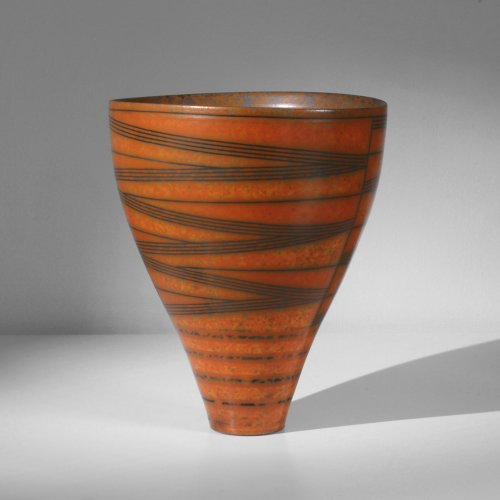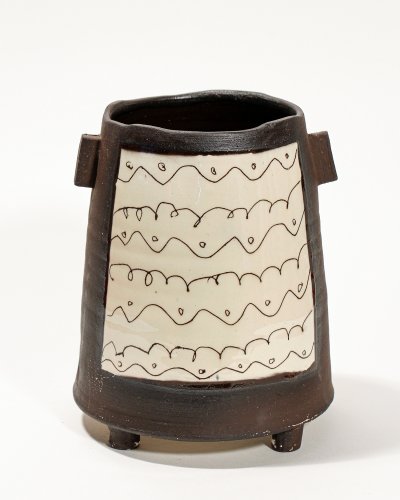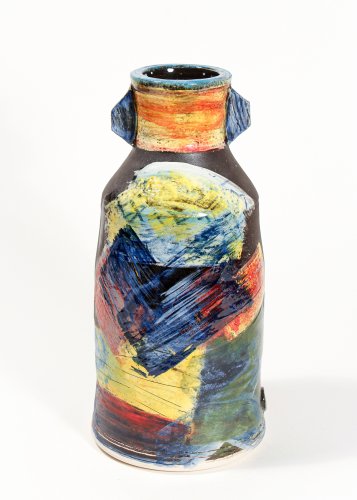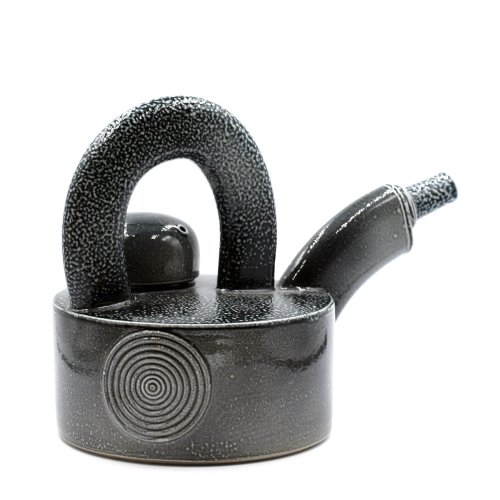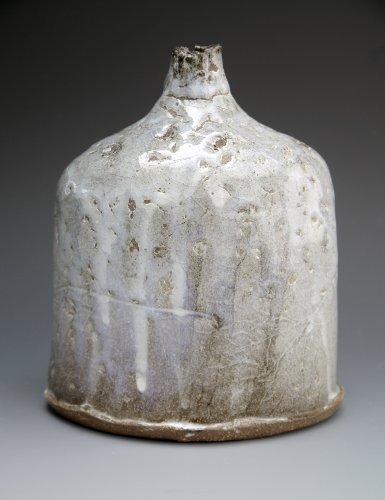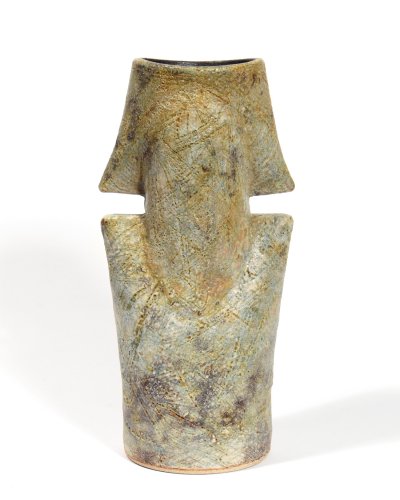Ceramics are clay products made permanent by heat.
The word comes from the Greek "keramos" meaning pottery or potter. Ceramic objects usually have a glaze applied and may be coloured or decorated. The term is often used by the individual potter when the name 'pottery' seems too limiting a description of the work.
In this section:
- Burnished
- Celadon
- Crystalline Glaze
- Earthenware
- Glaze
- Inlay
- Lustres
- Porcelain (Ceramics)
- Raku
- Salt glaze
- Sawdust Firing
- Sgraffito
- Stoneware (Ceramics)
- Tenmoku
- Terra Sigallata
- Vapour Glazing
- Wood Firing
- Burnished
Burnished work has had its surface rubbed with a hard object such as a polished stone, the back of a spoon or a strip of sprung steel. This smoothes and polishes the clay. The use of finer clays ensures a smoother and shinier surface than coarser clays, as will allowing the pot to dry more before burnishing, although that risks breakage. Stained slips can be applied to leather-dry clays using painting techniques to add decorative elements or the piece can be dipped if a uniform colour is desired.
See artists:
- Back to top
- Celadon
A grey-green to grey-blue stoneware and porcelain glaze which originated from China and was perfected in the Song Dynasty. The classic celadon glaze is thickly applied and semi-translucent.
- Back to top
- Crystalline Glaze
These are glazes in which crystals have formed during the cooling process. The Crystals give opacity, matt surface and interesting visual effects. There are three types: glazes with separate crystals within the glaze just visible to the naked eye; glazes opacified or made matt by crystals; and glazes with large surface crystals.
- Back to top
- Earthenware
A low fired form of pottery in which the porous body is waterproofed, either totally or partially, by a covering glaze. The lower temperature at which it is fired (below 1100oC) allows for a wide range of glaze colours and a particular quality of visual shine and texture.
See artists:
- Back to top
- Glaze
A glaze is a layer of glass which is fused into place on a pottery body. The glaze provides a non-porous protective layer and is also decorative, providing colour, shine and textural contrast with the body. Some makers freely apply slips in a painterly abstract manner to create highly individual work.
Various firing techniques can be used in addition to normal glaze-firing. Sulphur, various salts or ashes will stick to pieces within the kiln and melt onto their surfaces, often resulting in a mottled texture which has a distinctive "orange peel" feel.
See artists:
- Back to top
- Inlay
A decorative technique in which a pattern is carved into the clay at the Leather Hard stage and a soft contrasting coloured clay is forced into the recess. When the clay dries a little the excess is scraped of to reveal the pattern.
- Back to top
- Lustres
Lustres are metallic surfaces on glazes. Gold, Silver, Copper, Platinum and Tin are commonly used.
- Back to top
- Porcelain (Ceramics)
A hard strong and vitrified ware, usually fired above 1200˚C in which the body and glaze mature at the same time and form an integrated body-glaze layer. Stoneware glaze surfaces are scratch resistant. Most stoneware pottery is thrown, for which a high degree of plasticity is required. Good plasticity is often accompanied by a long workability range which allows turning and the adding of handles etc.
Porcelain is a vitrified, white and translucent ware. The toughness, strength and translucence of porcelain are the result of the formation at high temperatures of between 1200˚C and 1400˚C of the mineral mullite and glass within the clay body.
The name porcelain is said to have been coined by Marco Polo in the 13th century from porcelino, the name of the translucent cowrie shell whose upper surface is said to resemble the curve of a pig's back.(Latin porcella, a little pig).
According to a well known Chinese saying Porcelain should be 'as white as jade, as thin as paper, as bright as a mirror, as sound as a bell'.
- Back to top
- Raku
Popular modern Raku, typically made from a stoneware clay body, is often recognized by a velvety black body contrasted with a black-stained crackle of white, yellow, blue and turquoise glazes, some with lustrous glints of reduced copper red. These effects are achieved by low firing temperatures, lead glazes, and the removal of pieces from the kiln while still glowing hot. The process is known for its unpredictability, particularly when reduction is forced, and pieces may crack or even explode.
- Back to top
- Salt glaze
The technique of salt glazing was discovered around the 14th Century and was established in England by the 17th Century.
Salt glazed pots are fired in the kiln in the normal way except they are not covered in glaze before being packed (except the inside of deep or lidded pots which the salt wouldn't reach).
The glazing actually takes place during the firing. Salt or Soda is introduced to the kiln between the temperatures of 1120oC and 1280oC and carried round by the live flame. The silica i the clay is fluxed by the sodium in the salts. The sodium vapour attacks the surface of the pots causing the silica to melt and form a glaze on the outside of the clay.
Salt glaze achieves particular qualities of texture,colour and surface which no other technique can give. One trademark pattern is the 'orange peel' texture formed by the silica. It is a revealing process; because the surface of the clay is not coated with a glaze, marks, edges, textures and patterns are very distinctive.See artists:
- Back to top
- Sawdust Firing
A simple system of firing during which pots are set into sawdust, within a brick or metal lidded box. The sawdust burns slowly achieving sufficient heat to turn the clay into pot. Pockets of oxidation and reduction are caused which produce interesting decoration especially on burnished red clays.
- Back to top
- Sgraffito
A scratched decoration especially when the scratched line or area usually reveals a different colour. The scratching is done at the leather-hard stage and can be achieved with many tools from single cutters such as pieces of wood and metal to multiple texturizers, such as hacksaw blades.
- Back to top
- Stoneware (Ceramics)
A hard strong and vitrified ware, usually fired above 1200˚C in which the body and glaze mature at the same time and form an integrated body-glaze layer. Stoneware glaze surfaces are scratch resistant. Most stoneware pottery is thrown, for which a high degree of plasticity is required. Good plasticity is often accompanied by a long workability range which allows turning and the adding of handles etc.
See artists:
- Back to top
- Tenmoku
A stoneware glaze which is deeply stained by iron oxide. Tenmokus are usually dark brown and black with some rust patches, but are occasionally yellow, green or purple. Good tenmokus have an expressive depth and variation of colour which is achieved by the use of a glaze that has some flow. This means it can fill hollows and give thickness variation on the pot's form.
- Back to top
- Terra Sigallata
Very fine relief-decorated earthenware with a smooth red gloss finish. The gloss is an exceptionally fine slip coating.
- Back to top
- Vapour Glazing
During the firing process, whilst the kiln is cooling, stannous chloride is introduced to the kiln. It vapourises forming a light, lustrous rainbow effect on whatever part of the pots it touches.
- Back to top
- Wood Firing
Firing by the original fuel, wood, gives a particular quality to the unglazed parts of stoneware and to a lesser extent earthenware. The wood must be absolutely dry. It is usually prepared and stored at least a year in advance.
Wood ash, readily available because kilns were traditionally wood fired, is one of the most variable materials a potter can use. Colours from oranges and browns through to greys and greens can be achieved. Parts of the pot are often are left unglazed as the interaction between ash and clay is more interesting than that of ash and a glazed surface.
- Back to top
